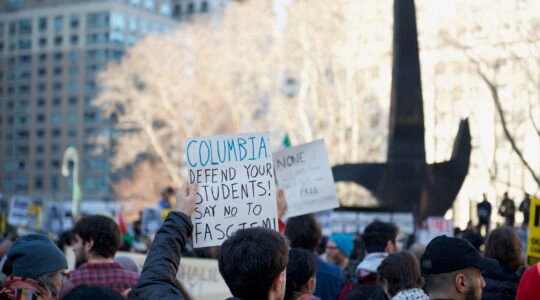In the mythology of the creation of the State of Israel, there is no event that looms larger in the public Israeli and American Jewish consciousness than the victory in the 1947-49 War of Independence. The war is known variously as Milchemet Ha-Shichrur (War of Liberation — liberation, that is, from the British, the appellation favored by the left-leaning Hashomer Hatzair movement); Milchemet Hakomemiyut (War of Sovereignty, Ben-Gurion’s formulation, signifying the establishment of a new national Jewish entity); and Milchemet Ha’Atzmaut (War of Independence). In the popular mind, the “Exodus” version, visited in the 1950s upon several generations of American Jews, went like this: “The New Israeli Jew,” his back to the wall and protecting a beleaguered new nation, overcomes with indomitable spirit the venal Arab who is out only for plunder and murder.
There has to be more than this. The “Exodus” version does have limited merit and is accurate as far as it goes. But this telling of the history leaves out four crucial dynamics.
The first two had less to do with the Jews of Eretz Yisrael and everything to do with the Arabs. The reality was that the Arabs in 1948 were in utter disarray. There was no unified Arab front, the invading Arab states did not have a single, coheren war aim and there was little coordination between Arab forces; indeed, Arab armies often acted at cross-purposes. The Egyptians were interested in occupying the Negev, period. The Syrians had their eye on the Galilee. For their part, Jordan (or Transjordan, as it was called until 1949) wanted hegemony over the West Bank, which was the key area allotted to a Palestinian state under partition. The result was no coherence in military planning and action or in Arab political leadership.
In sharp contrast, whatever deep internal ideological and political differences existed in the Jewish community in Palestine, and subsequently in Israel, Israel had a unified war aim. There was a single, unchallenged, agenda: to ensure the viability of the new state and to prevent the Arab states from potentially dismantling it. To preserve that sense of unity, one of Ben-Gurion’s first acts following declaration of statehood was the unification of the four fighting militias that came out of radically different ideologies — the Haganah, the Palmach, Etzel and Lehi — into the Israel Defense Forces. The point was that Israeli military leadership had a coherent agenda that was informed by national and political goals around which there was consensus.
Second, there was little coherence in the Palestinian Arab community. Its leadership had been decimated and its economy much weakened as a result of the Arab Revolt in 1936-39, during which much of the Palestinian Arab leadership fled. Arab Palestine had not recovered from the revolt. There was a leadership vacuum.
Third was the crucial matter of arms and armament. Again, conventional wisdom is not well served by the facts. At the beginning of the conflict, in 1947 and into mid-1948, there was indeed a substantial ordnance gap between Israel and its invaders, and the military condition of the new state was in fact critical. But this gap was soon closed. The arms embargo, imposed on all parties, had its impact primarily on the Arab states; the bullet that was fired could not be reloaded, the rifle that malfunctioned could not be repaired, the tank that was destroyed could not be replaced. In contrast, after the first truce (June 11-July 9), arms began pouring into the Israel. The well-known story of Haganah agents running around Europe with suitcases stuffed with dollars, buying up arms, is not a myth. The arms embargo, which was binding for all parties, was in fact a one-sided affair, favoring Israel. Additionally, military historians agree that the day-to-day maintenance and repair of armaments was superior in Israel.
Nor can we ignore the role played by agriculture and food, often overlooked by historians of the period. This fourth dynamic was crucial. Palestinian Arab agriculture was a mess, not the least a result of the 1936-39 revolt, which among other factors had decimated tracts of Arab farmland throughout Palestine. The Yishuv (pre-state Israel), in contrast, had a well-organized agricultural establishment, and an efficient food-distribution system. Yes, some outlying kibbutzim and moshavim were ravaged, and Jerusalem suffered grievously under siege. But by and large Israel experienced few problems in feeding its population — and its army. On the Arab side, the reality was that the Palestinian Arabs could barely feed themselves, let alone sustain invading Arab armies.
All of that suggests a reading of Israel’s War of Independence stripped of its mythopoeic persona. As we enter Israel’s eighth decade, Israelis and American Jews recall our military triumphs and our military challenges, and we return to the central lesson we learned from Milchemet Ha-Shichrur: political strife and ideological differences can be overcome. In fact, they must be overcome if we are to ensure the continuity, survival and triumph of our Jewish polity and state.
Jerome Chanes is a senior fellow at the Center for Jewish Studies of the CUNY Graduate Center and the author of four books.
The New York Jewish Week brings you the stories behind the headlines, keeping you connected to Jewish life in New York. Help sustain the reporting you trust by donating today.




